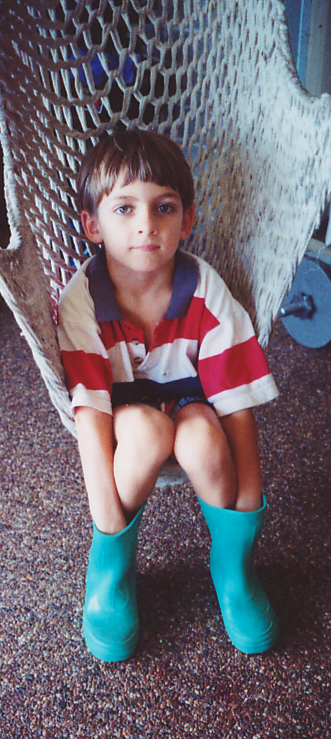 My child is having difficulties at school. He’s bright, but he’s not doing as well as he should. I’m not sure what’s wrong.
My child is having difficulties at school. He’s bright, but he’s not doing as well as he should. I’m not sure what’s wrong.
Help Your Child to Learn, contains a questionnaire to help identify where difficulties lie in an individual child and gives a lot of information about Learning Difficulties & Disabilities. This is a great place to start. It will help you decide on the best course of action for your child. Each child is different, and there are often a number of factors affecting a child’s ability to learn. Pinpointing problem areas will help you locate appropriate specialists when needed and avoid the expense and frustration of following every new treatment. We also have a free LD profile test to help with this.
The first area that you will need to explore is that of diet & allergies. Problems in these areas alone can cause difficulties in learning or at least significantly contribute to the problem.
Secondly, we’d recommend you run the Move to Learn movement program with your child. While there may be other problems affecting your child, such as auditory, sensory or visual processing difficulties or perhaps allergies, we’ve found that most children presenting with learning difficulties are inhibited by retained primitive reflexes and immature neurological processing. The Move to Learn movement program addresses this, and can be beneficial for all children regardless of whether they have difficulties with learning or not.
You can run the program with your child by yourself by simply purchasing a copy of the Move to Learn DVD and following the simple, demonstrated instructions. It’s easy and it’s fun. All you need is a DVD player, a TV, a little space and 15-20 minutes a day.
Read what other parents are saying.
Which book should I buy first?
Each of the books covers different material and has a different focus. Which one is right for you will depend on your own circumstances and background. For a comprehensive understanding, it’s best to read all of them, but briefly;

Help Your Child to Learn, contains a questionnaire to help identify where difficulties lie in an individual child. It also gives a lot of information about Learning Difficulties. This is a great place to start, especially if you are a parent.
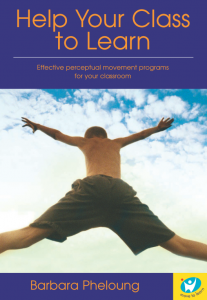
Help Your Class to Learn is great for teachers, keen parents or practitioners in the field of Learning Difficulties. It has a lot of information about setting up a perceptual movement program in a school, including suggestions of equipment , (much of which you could make yourself), & activities.
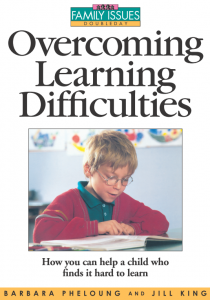
Overcoming Learning Difficulties helps with diagnosis and presents an extensive program of graded activities which are easy to follow. Full of practical suggestions and sequences of activities covering a wide range of areas, it is ideal for planning both therapy and home programmes.
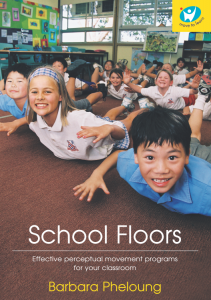
School Floors provides a brief overview of the history of Move to Learn and gives information about things that can be done after the movement program as well as advice about how to get the program into schools. There are chapters on diet, nutrition, food additives, allergies, sound therapy, auditory processing, the effect of retained primitive reflexes, playground management and improving social interaction. Particularly helpful are a quick functional vision screening test, a ‘ready for school?’ test and a ‘what to look for before the third birthday’ chapter. There are exciting contributions by many leading educators, therapists and specialists in the field of learning difficulties including: Veronica Steer, Dr Marilyn Dyson, Chris Chapparo, Margaret Greville, Pye Twaddell, Sue Larter, Sue Dengate, Jacqueline Lee, Sue Mackay, Julia Dive, Sue Mackay, Michelle Learmouth, Rachel Fisher, Winsome Richards, Mike Almond & Carol Hewatt.

Ten Gems for the Brain This e-book explains the program in simple English with lots of diagrams and is easy to follow. It doesn’t explain why the program works, or provide the same depth of detailed information that the books provide, but it does explain how to do the program, and it is all you should need to run the program.
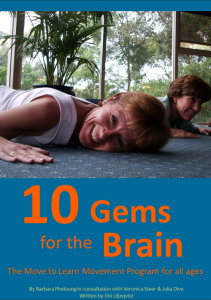
Ten Gems for the Brain for all ages. This e-book is an extended version of our regular Ten Gems for the Brain, with deeper explanations into the ‘why & how’ of what we do. It has been developed to meet the needs of adults (older teens through to seniors) who would like to benefit from our program. There are tips and adaptations for seniors and those with disabilities or physical restrictions; photographs to illustrate and a large reference section.
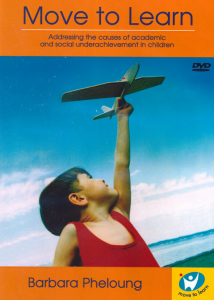
The DVD, Move to Learn, is designed for a parent, teacher or helper to be able to run the Move to Learn program with a class or an individual child. Each of the Movement Sequences is demonstrated in an easy-to-follow-along-with manner, with clear instructions and important information.
What equipment is needed to get started?
All you need to run the program is the Move to Learn DVD, a DVD player, a TV or the e-book Ten Gems for the Brain – and some floor space.
 Are the movements suitable for all ages, including teens and adults?
Are the movements suitable for all ages, including teens and adults?
Yes, they are. They can be undertaken at almost any stage of life with similar neurological benefits. The movements can help with recovery after an accident or ill health and address immaturities that may still remain from childhood—acting as a kind of neurological reboot. Most importantly, the resulting neurological improvements from doing this program can lead to more confidence, happiness and satisfaction in daily living. Our e-booklet: Ten Gems for the Brain; The Move to Learn Movement Program for All Ages, has been developed to meet the needs of adults (older teens through to seniors) who would like to benefit from our program. This e-book is an extended version of our regular Ten Gems for the Brain, with deeper explanations into the ‘why & how’ of what we do. It There are tips and adaptations for seniors and those with disabilities or physical restrictions; photographs to illustrate and a large reference section.
Does this program help address retained primitive reflexes
Close links have been identified between the inhibition of primary reflexes and the attainment of gross-motor milestones.
Reflexes are often used as landmarks and measurements of CNS maturity. They play a vital role in survival for crucial periods but should then undergo inhibition or transformation. If this doesn’t happen, Neuro-Developmental Delay, (the continued presence of a cluster of Primitive Reflexes above the age of 6 months (12 months at the latest), in combination with absent or under-developed Postural Reflexes above three and a half years of age) will often result.
Some signs of neuro-developmental delay are:
*Poor concentration
*Emotional presentation
*Poor impulse control
*Weak balance and motor skills
*Weak posture, sitting position
*Weak academic performance, organisation of work, copying from board
Obviously, these things will have a major impact on academic learning.
The Move to Learn program has included the inhibition of persistent primary reflexes as a core element in its program, addressing the underlying functional deficits that children with various difficulties have shown. The 10 simple movement sequences cover all the essentials that every child needs, and in the right order.
Do you sell the books internationally?
Yes, we do sell the books internationally. They can be purchased in print or e-book format can be bought through this website and through major retailers across the globe.
My child is a teenager, and desperately needs help, is the Move to Learn Program too young for him?
 Certainly not. Many adults have done the program with great success. It usually works best for teenagers and adults if they are involved in their own assessment. They can watch for and record improvements. Taking a leadership role, perhaps demonstrating for others or leading groups of younger children, can be a good motivator for teens – as can bribery!
Certainly not. Many adults have done the program with great success. It usually works best for teenagers and adults if they are involved in their own assessment. They can watch for and record improvements. Taking a leadership role, perhaps demonstrating for others or leading groups of younger children, can be a good motivator for teens – as can bribery!
Our e-booklet: Ten Gems for the Brain; The Move to Learn Movement Program for All Ages, has been developed to meet the needs of adults (older teens through to seniors) who would like to benefit from our program. This e-book is an extended version of our regular Ten Gems for the Brain, with deeper explanations into the ‘why & how’ of what we do. It There are tips and adaptations for seniors and those with disabilities or physical restrictions; photographs to illustrate and a large reference section.
I am an adult, will the program work for me?
Many adults have done the program with great success. It usually takes a little longer the older you are, the optimum time for these movements is during the pre-school years, but improvement should be possible with patient persistence.
Our e-booklet: Ten Gems for the Brain; The Move to Learn Movement Program for All Ages, has been developed to meet the needs of adults (older teens through to seniors) who would like to benefit from our program. This e-book is an extended version of our regular Ten Gems for the Brain, with deeper explanations into the ‘why & how’ of what we do. It There are tips and adaptations for seniors and those with disabilities or physical restrictions; photographs to illustrate and a large reference section.
Is there an assessment I can do?
Help Your Child to Learn, contains a questionnaire to help identify where difficulties lie in an individual child and it gives a lot of information about Learning Difficulties. This is a great place to start. It will help you decide on the best course of action for your child. Each child is different, and there are often a number of factors affecting the child’s ability to learn. Pinpointing problem areas will help you locate appropriate specialists when needed and avoid the expense and frustration of following every new treatment.
You could also take a look at the free interactive LD profile test on this website.
Do I need to buy a franchise or pay an authorisation to use the program in my school?
No, we don’t put restrictions on where the program can be used, but what we do ask is that the copyright is respected.
We ask that our work isn’t photocopied, cut-and-pasted into other works, translated or reproduced in any other way without our express permission, as income from the books & DVD is our only source of income.
In universities and teachers’ colleges, we don’t ask for a fee to include the program on the curriculum but we do ask that each student purchase a copy of our DVD and at least one of our books, and that copies of all the books are made available in the University Library.
For people that want to use the program as part of their own business, we only ask that they buy our products, respect our copyright and refer any they are working with to buy their own copies of our publications. Again, no photocopying or reproducing for clients. We don’t sell franchises or offer exclusive territories because we want everyone to be able to use the program as freely as possible.
